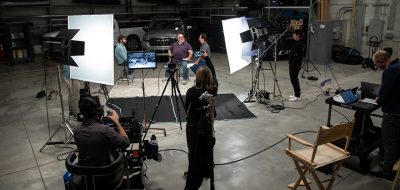Throughout the year, industry leaders and innovators come together at major events and conferences to share insights and learn more about the future of their space. While it’s always valuable to have some of your team members on the ground to discuss your brand and offerings at these important industry events, a successful, comprehensive marketing strategy involves more than just the right in-person talking points.
In order to establish your brand as a thought leader and maximize your opportunities to connect with prospects, you need to create and distribute the right event content before, during, and after a conference takes place.
BEFORE THE EVENT
When it comes to the biggest and most important events in your industry, you should start publishing relevant content weeks (or months) in advance. By establishing the right strategy here, you can take advantage of the opportunity to increase your site traffic and brand awareness.
BLOGS
There are two main approaches you can take when it comes to pre-conference blogs. One option is to create a post that focuses on the future event itself. This kind of blog can cover what attendees should expect, the themes of the conference, session highlights, and other relevant information. These posts are also the perfect place to call attention to any panels or sessions your team will be involved in.
Another option is to create blog content around the key themes of the upcoming conference. For example, imagine that you work in the e-commerce space and interactivity is going to be a major topic at an upcoming industry event. Consider developing associated interactivity 101 and roundup posts that empower you to define your brand as a leader in this space. Getting in on a trending conversation in this way can give you an organic search engine optimization (SEO) boost.
WEBINARS
Similarly, you could create webinars that focus on the major themes and topic areas that will be discussed. By having one of your internal subject matter experts (SMEs) lead the webinar, you can further highlight your team’s expertise—making prospects even more interested in connecting at the event itself.
ASSETS REQUIRED FOR SCHEDULING MEETINGS
Is your team planning on hosting meetings with customers and prospects while they’re at the event? If so, you should develop a landing page where users can book a specific time slot. And don’t forget to create various marketing assets that will drive your audience to this page.
One particularly engaging content type to use for this purpose is a short promo video. These videos can be shared on social and included in any pre-event emails you send out to prospects and customers. A straightforward, simple formula to use here is to leverage b-roll event footage from previous years to make up the majority of the visuals. You can then incorporate on-screen text or a voiceover to explain that your team would love to connect at the event—and provide all the pertinent information about scheduling a meeting. If you have the necessary interactivity integrations in place, you can even add a call-to-action (CTA) at the end of the video with a link to the landing page where individuals can book a specific time slot.
DURING THE EVENT
Some of the most exciting and impactful event content is published or distributed during a conference. This content serves one of two purposes. The first is to share first-hand insights and exciting reveals with those who could not make it in person. And the second is to provide your marketing and sales team with physical assets that they can distribute.
SOCIAL POSTS
Live tweeting has become a hugely important part of every event content strategy. Once you have a plan in place for which team members will be attending a particular conference, consider who will have the time and social media expertise necessary to be in charge of live tweeting. Make sure to limit this responsibility to one or two individuals—and clearly define who is in charge of posting about each session. In particular, powerful social content can incorporate photos taken during the event itself and inspiring quotes pulled from speakers.
LIVE STREAMS
If you want to take your event content to the next level, consider incorporating a live stream into the mix. Depending on your technical capabilities and integrations, you can stream this content on a hosted site or your social channels. If you have the necessary permissions and access levels, you can potentially stream panels your organization is involved in—as well as unique content, such as in-person interviews your team conducts.
VLOGS
Daily vlogs are another type of valuable video asset you can create during an industry event. These videos can fuel social content and serve to recap what’s happening on the show floor each day. Overall, this content can provide your audience with a first-hand visual peek into what it’s like to be at the conference.
DATASHEETS
If you have a booth or other space where prospects and customers can arrange to meet with your team, you should come prepared with printed assets to distribute. Datasheets that highlight the specific features, advantages, and use cases of your products can be a really valuable tool to drive these in-person conversations and encourage new contacts to follow up with your team at a later time.
PRESS RELEASES
If your team is planning on making any big announcements during an industry event, you should make sure your public relations team has an approved press release that’s ready to go live right away. These announcements may revolve around new product releases or updates, new executive leaders of your company, and other exciting changes.
AFTER THE EVENT
Don’t let the conversation end after a conference is over. There are a variety of different ways you can leverage content to keep the momentum going.
RECAP BLOGS AND VIDEOS
Consider developing blogs and videos that summarize the most exciting announcements, trends, and themes that your audience should be aware of moving forward. This content will be particularly enticing for those who couldn’t make it to the conference, but the assets will also be valuable recaps for those who were there.
In particular, an event summary video can be a powerful and engaging asset to include in any follow-up communications you send out. This may include a post-event thank-you email to new contacts who took the time to meet with your team.
REPURPOSED CONTENT
Some of the content you create prior to or during an event can be repurposed down the line. For instance, if one of your team members gave a presentation, you can incorporate their slide deck and insights into blog content, LinkedIn posts, and more. You can also repurpose any live-streamed content by turning it into video-on-demand (VOD) assets. If you can find a way to make some of these assets evergreen, you can leverage this content for even longer.
WEBINARS
After a major industry event, you should have a solid understanding of some of the biggest trends that will be shaping your space for months to come. Capitalize on these trending topics by creating associated webinars. Is there a new type of technology that’s changing the game? Create 101-style webinars that introduce the basics. Is your target audience facing a new challenge? Develop product webinars that highlight how your offerings can help them overcome this hurdle.
It’s clear that content should play a major role in your overall event marketing strategy. By creating and distributing the right assets before, during, and after a conference, you can establish your brand as a thought leader and maximize your opportunity to connect with prospects.




